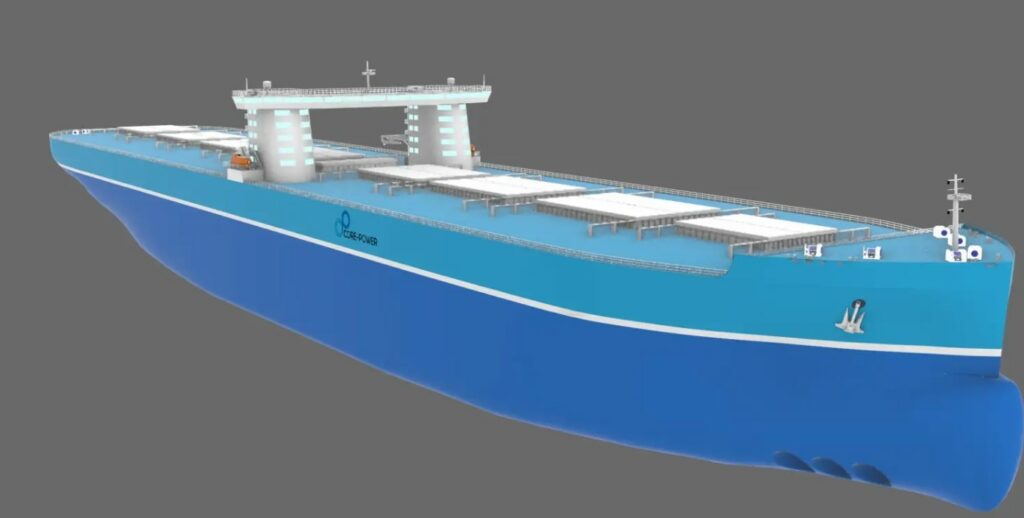 UK-based start-up Core Power has attracted Japanese investment for its floating NPP (FNPP) project. Some 13 companies, including Onomichi Dockyard and Imabari Shipbuilding, have invested about $80m in project, according to Nikkei Asia. Although Core released no statement on the development, it reproduced the Nikkei article on its website.
UK-based start-up Core Power has attracted Japanese investment for its floating NPP (FNPP) project. Some 13 companies, including Onomichi Dockyard and Imabari Shipbuilding, have invested about $80m in project, according to Nikkei Asia. Although Core released no statement on the development, it reproduced the Nikkei article on its website.
The paper noted that FNPPs “can theoretically be placed anywhere at sea and, because they float, they would not be affected by earthquakes” and “can also withstand tsunamis if placed offshore” Moreover, the electricity produced can be sent ashore and used to produce hydrogen and ammonia. FNPPs “are thought to be particularly marketable in Japan as an island nation,” Nikkei commented.
“With demand expected to grow worldwide, Japanese companies hope to become more involved in the technological development in areas where foreign businesses have an edge, such as modular nuclear reactors.”
Core Power, set up in 2018, is focusing on developing offshore nuclear power. The Japanese companies taking part in the project have subscribed to a third-party allocation of new shares by Core Power, which has raised about $100m and is now majority-owned by Japanese companies.
Core Power is developing a FNPP in collaboration with US-based TerraPower and power utility Southern, as well as France’s Orano.
The reactors developed by the four companies will be molten chloride fast reactors. According to Nikkei, the system uses a liquid fuel with a high boiling point that can operate at normal pressure to generate electricity. This eliminates the need for the pressurisation equipment used in conventional solid-fuel NPPs and allows the plant to be miniaturised. It also reduces the risk of accidents, such as meltdowns and explosions. The reactors have a planned output of 300 MWe each, “and three to four units would be equivalent to a conventional nuclear power plant”.
The construction cost is estimated at about half that of land-based systems, and the construction time can be reduced by 70%. “Core Power is interested in Japanese shipbuilding technology and hopes to work with Japanese companies to develop floating equipment for the project,” Nikkei said.
The company plans to launch a demonstration vessel in 2026 and commercialise it between 2030 and 2032. Core Power aims to build a track record overseas, then expand in Japan. It is estimated that the demonstration vessel will require approximately JPY50bn ($361m), and Core Power and the its three partner companies will share the cost. The investment by Japanese companies will also be used to fund development.
"We want to keep up with the world's latest technology trends," said an executive from Onomichi Dockyard, which decided to invest JPY1bn in Core Power. “Small modular reactors are expected to be easy to use in floating power plants and Japanese companies hope to gain expertise by participating in the project,” Nikkei noted.
In August 2022, Core Power, MIT Energy Initiative and INL were awarded research funding by DOE's Nuclear Energy University Program, a three-year study into the development of offshore floating nuclear power generation in the USA.
Core Power is also a participant with US-based TerraPower and power utility Southern Co, in the Molten Chloride Reactor Experiment (MCRE). In 2021, Southern Company DOE signed an agreement to design, construct and operate the MCRE as a proof-of-concept critical fast-spectrum salt reactor. MCRE aims to be which the world's first fast-spectrum salt reactor to achieve criticality at INL, Collaborators in the MCRE project are Terrapower, INL, Orano (USA) Federal Services, Electric Power Research Institute, and 3M Company.
The project is supported through the DOE's Advanced Reactor Demonstration Program (ARDP) under a five-year, $170m cost-shared funding agreement. It will provide crucial operational data to support the future development of TerraPower's Molten Chloride Fast Reactor (MCFR), informing the design, licensing and operation of a demonstration reactor.
Core Power’s plan to launch a demonstration vessel in 2026, appears to be over ambitious. Core Power receives no mention at all in the International Atomic Energy’s comprehensive publication on Advances in Small Modular Reactor Technology Developments published in 2022. Of the 13 molten salt reactors (MSRs) described in the publication only two have reached the detailed design stage. And most advanced of those, Terrestrial Energy’s integral molten salt reactor, which has already made some progress towards licensing, does not plan to begin construction until 2027. Two of the 13 envisage floating NPPs – Seaborg’s compact MSR (Denmark), which is still in the conceptual design stage, and US-based Thorcon’s MSR which is in the preliminary design stage. However, both of these have unrealistic completion dates of 2027/28, given that neither has made any real progress towards licensing.
Image: Rendering of Core Power's floating nuclear power plant (courtesy of Core Power)


